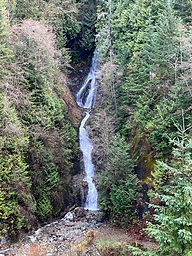Invasive Species Action
- kc dyer

- Feb 26
- 3 min read
Ivy Pull planned for March 2

Ready to get a start on spring gardening? This weekend intrepid Butterflyway rangers Hana Boye and Val Morton are gathering a group of stalwart gardeners ready to brave whatever the weather brings, and make a start on getting rid of a particularly invasive species in the village: ivy.
"We've chosen the date so we can begin this pull for before ground-nesting birds are active," said Morton.
But why ivy? How can this ubiquitous plant be considered invasive?
"Invasive plants are non-native, meaning that they did not evolve in this ecosystem," said Morton. "Therefore they don't have a close relationship with other organisms in the ecosystem."
She says that both English and Irish ivy were introduced from Europe, and both are considered invasive because they grow rapidly and outcompete native species.
"These forms of ivy can spread across the forest floor and up into the tree canopy," said Moye. "This behaviour can create an ‘ivy desert’, preventing beneficial native plants from establishing, blocking sunlight from trees, and providing a hiding place for various pests and garbage."
They note that not all forms of ivy are invasive, and in fact the Invasive Species Council of BC recommends Boston ivy as a beautiful alternative to English and Irish ivy.
"Removing ivy from you own gardens can be very satisfying," said Boye. "But start small and try to enlist lots of helpers."
Morton and Boye are asking people to join them at the Village Hall between 10 a.m. and 2 p.m. this Sunday and to wear warm clothes and gardening gloves. The group will focus on clearing an area near the Village Office with the goals of opening the space for planting indigenous species and inspiring other residents to clear invasive ivy from their own gardens.
"With respect to the actual ivy pulling process, there is an excellent information pamphlet available through the Invasive Species Council of BC," says Boye.
Once the invasive plants have been pulled, Morton and Boye say that replanting the area helps prevent re-invasion, promotes biodiversity and results in more successful site restoration. "Two beautiful ground covers for shady areas are false lily of the valley (Maianthemum dilatatum) and false Solomon’s seal (Maianthemum racemosum)," said Morton.
"Native strawberry (Fragaria virginiana) will grow happily in shady or sunny locations," she added. Other excellent replacements include red flowering currant (Aquilegia formosa), tall Oregon grape (Mahonia aquifolium), dull Oregon grape (Mahonia nervosa), salal (Gaultheria shallon), oceanspray (Holodiscus discolor), deer fern (Struthiopteris spicant) and sword fern ) Polystichum munitum).
And what about when ivy is helping retain steep slopes beside driveways or homes? Boye suggests planting sword ferns, salal and Oregon grape on steep slopes. Red flowering currant, salmonberry, oceanspray, black-eyed Susan, Douglas aster, pearly everlasting and Nootka rose could also be planted. She added that if English ivy is the only option, keeping it contained and preventing it from climbing trees is advised.
Boye notes that one of the reasons invasive plants are so pervasive is due to their resilience within our ecosystem, and so the disposal of these plans is important.
While it depends on the species, high heat above 150 degrees Celsius is typically necessary to make seeds and other plant matter unable to regenerate. "For this reason, invasive plants should not be composted at home," she said. "They should be disposed of at an industrial composting facility that accepts invasive species, or tightly bagged and disposed of at the landfill/transfer station."
During Saturday's event, Lions Bay resident Ingrid Wray and Sea to Sky and Invasive Species Council member Clo Godbout-Gauthier will give a seminar on weaving ivy
vines into creative baskets. Morton encourages any interested residents to participate.
"The Village Hall will be open for the weaving activity and as a warm location where you can enjoy a delicious scone and some tea or coffee."
In addition to wearing warm, weather-proof clothes and gardening gloves, she invites participants to bring their own bag lunch, along with hand pruners and weeding forks if they have them.
Teens who need service hours for school are encouraged to join in, and Morton says they will be happy to provide documentation of the teens' efforts.
Later in the spring, the area cleared by volunteers will be planted with native plants.
Have a gardening question or comment? The Watershed values your opinion. Share your thoughts below, or email editor@lionsbaywatershed.ca
Like what you're reading? For as little as $5/month, you can support local independent journalism by subscribing to The Watershed HERE.








Comments